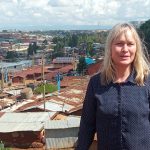A better connection between cities and rural areas improves food and nutrition security in both regions
This is part 1 of a blog series on food systems. This article was written by Katrine Soma and Siemen van Berkum.
Developing countries are urbanising rapidly. Many urban dwellers are poor and have to deal with malnutrition and limited access to healthy food. How can their food security be improved? And how can the city and the surrounding agricultural countryside be better connected so that farmers around cities can benefit as much as possible from the growing demand for food in the cities? Strategic interventions and practical solutions are needed, with full engagement of local actors, to ensure food security in both urban and rural communities improves. Changing demands in urban areas impact rural areas choices of investments and production.
In Kenya, for instance, people are moving into urban slums like Kibera, part of Nairobi. In research about ways to provide residents of Kibera with more and better food we have connected rural areas in Nyeri with Kibera through a new fish value-chain. In Nyeri, people do not traditionally eat fish, but the area has a growing fish production and is located at a distance of about 100 km north of Kibera.
A new fish value chain
We discovered that small-sized fish not marketable elsewhere could be supplied affordably to the vendors and consumers in Kibera. The demand for fish products is increasing, also among traditionally non-eating communities of fish in Kibera and other slums in Nairobi. Upscaling of supply of affordable small sized and nutritious fish will solve the critical challenge of ensuring affordable nutritious food as fish is. Equally important, it will also result in upscaling of fish production among the rural areas across Kenyan fish farmers.

Illustration: Bertram de Rooij
Changing farming practices
The increasing demand of fish in Kibera is changing farming practices in rural areas. Because fish offers more opportunities to farmers, they invest more in improving production systems. Also, more farmers will begin with fish farming on their farms or in community dams. With more investments, value chain environmental bottlenecks such as pollution by feed are tackled, which improves water quality. Nyeri is closer to Kibera than Lake Victoria (about 380 km), so even travel costs and fuel use get reduced if a shift takes place towards more supply from Nyeri.
Work with communities
Strengthening the connections between the urban and rural areas in developing countries will ensure increased access to healthy, affordable and sufficient food both in rural and urban areas. In our view, this begins with understanding the changing demand in cities and its impacts in rural areas. It is also important to invest in locally highly demanded nutritious food products, and support the strategies of rural farmers to follow up on changing urban demands. And, last but not least, it is crucial to work with communities whose arrangements often are informal, because social capital, trust and motivation can be found here and is needed for real cooperation.
Read more:
- Feeding cities and migration settlement project at WUR
- To be presented at Circular@WUR
- A rural-urban food system approach
- Documentary: a fish food system with small sized affordable fish stemming from Nyeri County delivered to consumers in the Kibera informal settlement in Nairobi
- Kibera Workshop report
- The Kibera documentary
- Webinars in November 2020:
- Webinar 1: Food futures
- Webinar 2: Stakeholder representation
- Webinar brief
- Article about Kibera in Vice Versa

